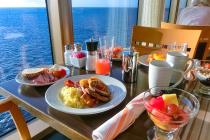Local Food Experiences in Europe
One of the best parts of traveling is sampling culturally unique foods from new places. The history and personality of an area is experienced in its flavors, and this is especially true in Europe. Below is a helpful overview of the culinary traditions and foods you’ll find on your Christian tour through Europe.
Culinary Traditions of the Czech Republic
Breakfast typically features cold dishes such as a slice of dark rye bread with butter and jam. Lunch, the principal meal of the day, is more hearty and served in three courses: a hot soup to start, followed by a main course often consisting of meat like pork, duck, or goose, with a side dish, and concluding with a sweet dessert or a small vegetable salad. Dinner usually consists of lighter snacks. Popular drinks include Kofola, a local soft drink similar to Pepsi, Vinea, a grape-based carbonated beverage, and coffee.
Polévka: a hot soup usually served as the first course at lunch made from smoked meat, tripe or fish.
Knedlíky: steamed and sliced bread-like dumplings served with gravy which can be wheat or potato based, and are sometimes made from a combination of wheat flour and stale bread or rolls.
Sauerkraut: a side dish of fermented cabbage. Known for its healthy probiotic properties.
Houbova Polevka Myslivecka: also known as Hunter’s mushroom soup, is made from local forest-grown mushrooms, onions and bacon.
Culinary Traditions of England
The traditional English breakfast, often called the 'Full English' or 'Full English Fry-up,' includes eggs, bacon, sausages, fried bread, baked beans and mushrooms. Lunch usually consists of a sandwich, often called a 'butty' or 'sarnie' in some UK regions, accompanied by chips, a fruit, and a drink. Dinner in Britain typically features a dish of meat and two vegetables, served with hot brown gravy made from the roast meat's juices, which is poured over both the meat and vegetables. Modern British cuisine also incorporates significant influences from the Mediterranean and more recent Middle Eastern, South Asian, East Asian, and Southeast Asian flavors.
Bangers and Mash: is a traditional British dish made of mashed potatoes and sausages. It is sometimes served with onion gravy, fried onions, baked beans and peas.
Shepherd's Pie: a comforting meat pie with veggies and a crust of mashed potato.
Toad in the Hole: a traditional English dish of sausages in Yorkshire pudding batter, usually served with vegetables and onion gravy.
Ploughman's Lunch: a cold meal of cheese, chutney, and bread. The dish can also include boiled eggs, ham, and pickled onions.
Culinary Traditions of France
Breakfast is usually a simple affair with bread slices topped with jelly or jam, accompanied by coffee or tea, though a fuller breakfast is also available at hotels. For lunch, sandwiches are common, often served on baguettes with traditional fillings like ham and cheese, and sometimes options like boiled eggs, tuna or salami, followed by a dessert. Dinner typically features a three-course meal, starting with an appetizer or soup, then a main dish with vegetables and either potatoes or pasta and finishing with a cheese course or a dessert. Mineral water is usually served with the meal, and still water can be requested.
Moules à la crème Normande: mussels cooked with white wine, Normandy cider, garlic and cream
Coq au vin: chicken braised in red wine, lardons (fatty bacon) and mushrooms
Pan-bagnat: sandwich with whole wheat bread, salad, hard-boiled eggs, tomatoes, tuna or anchovies and olive oil
Ratatouille: a vegetable stew with olive oil, aubergine (eggplant), courgette (zucchini), bell pepper, tomato, onion and garlic
Culinary Traditions of Germany
Breakfast typically consists of light fare, such as toast or bread with cold cuts and cheeses. Lunch is an ideal time to explore local butchers and bakeries for sandwiches and take-out or to try traditional snacks like sausage and fries from street stalls. Dinner, the main meal in Germany, usually includes meat and potatoes or noodles, served with a salad or vegetables. Contemporary German cuisine often incorporates lighter elements influenced by neighboring countries like Italy and France. Popular drinks include Apfelwein (apple cider), coffee and tea.
Döner Kebab: a Turkish lamb or chicken stuffed into bread, similar to Greek Gyros.
Bratwurst: a sausage usually composed of chopped veal, pork or beef which is then grilled, pan-fried or cooked in broth or beer. Most commonly they are served in a Brötchen (white bread roll made from wheat flour) and eaten with hot German mustard.
Pommes Frites: freshly fried potatoes that are crunchy on the outside, soft inside and fried twice. They are typically dipped in exotic mustards and mayonnaise, vinegar, curry sauce, or peanut satay sauce.
Koenigsberger Klopse: “meatballs from Koenigsberg” are made from minced pork served in a white sauce with capers and rice or potatoes.
Culinary Traditions of Switzerland
Various bread rolls are common at breakfast in Switzerland, often accompanied by cheese. The main meal is lunch, typically featuring meat, potatoes, and a green vegetable or salad. Dinner usually consists of a light snack of bread and cheese, capped off with rich Swiss chocolate. Popular drinks include Rivella, a soft drink, apple juice or cider, and Ovomaltine, known as Ovaltine in the USA.
Raclette: delicious melted cheese typically served with boiled potatoes, small gherkins and pickled onions.
Rӧsti: a favorite potato dish with layers of sliced potatoes and Swiss cheese browned into a pie shape.
Zürcher Geschnetzeltes: thin strips of veal with mushrooms in a cream sauce.
Älplermagronen (Alpine herdsman's macaroni): an all-in-one dish with macaroni, potatoes, onions, small pieces of bacon, and melted cheese.
On Tour
Each morning, you can expect to enjoy a full European breakfast featuring eggs, breakfast meats like bacon and ham, fresh fruit, various breads and juices. Breakfast also typically includes cold cuts, cheeses, muesli, mushrooms, and tomatoes. Lunch options range from buffets to cozy restaurant settings, while dinner buffets provide a mix of local and traditional dishes, emphasizing fresh produce. Tap water is safe to drink across Europe, with bottled water readily available; coffee and juices are included at breakfast, with water served at other meals and additional beverages available for purchase.
Special Dietary Needs
If you have a specific food allergy or special dietary needs, we recommend that you plan for your unique needs before your trip. For the most part, you will find enough variety in buffets or in restaurants for all meals to enjoy the region's foods while still maintaining your diet. Bring some heat-resistant snacks to supplement your diet during touring days. You may also want to search online for resources to help you communicate your dietary needs in a foreign culture and language.
For more information, please call one of our Reservation Coordinators at 800 247 1899, Monday through Friday between 8:30am – 5:00pm, Pacific Time.






